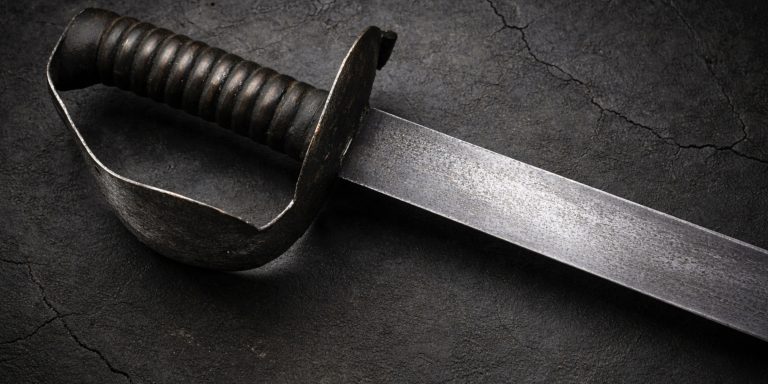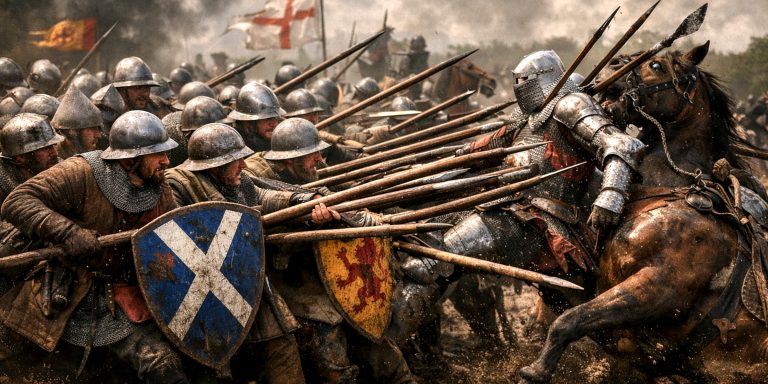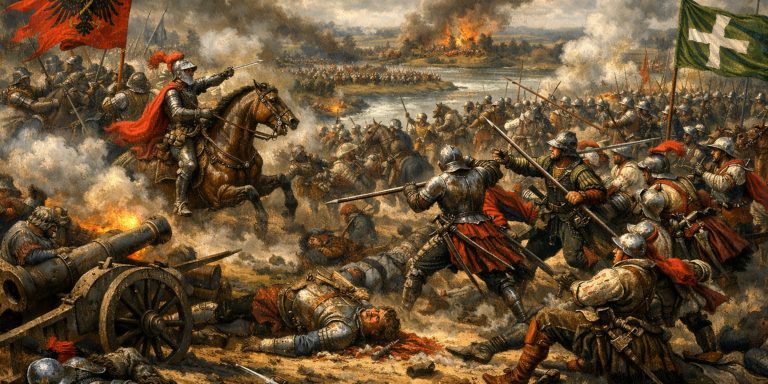
The Oakeshott Type XIV represents a fascinating period of transition in medieval European sword design. Emerging around the late 13th to early 14th centuries, it bridged the gap between the cutting-focused blades of earlier knightly swords and the thrust-capable forms of later medieval weapons. Compact, broad, and designed for versatility, the Type XIV was the knight’s answer to evolving armour and changing battlefield demands.
Its distinctive short, wide blade and acute point made it highly effective both on foot and horseback, combining cutting power with emerging thrusting capabilities. This was the sword of knights adapting to an era when mail was being reinforced by plate, and agility mattered as much as strength.
Specification
| Feature | Description |
|---|---|
| Type | Oakeshott Type XIV |
| Date Range | c. 1270–1340 |
| Blade Length | Typically 28–31 inches (71–79 cm) |
| Blade Width | Broad base, often around 2.25–2.75 inches (5.7–7 cm) |
| Blade Form | Short, wide, with a pronounced taper and an acute tip |
| Fuller | Broad and shallow, often running two-thirds of the blade’s length |
| Cross-guard | Straight or slightly arched; 5–8 inches wide (12–20 cm) |
| Grip Length | Short, one-handed, around 3.5–4.5 inches (9–11.5 cm) |
| Pommel Type | Commonly of Type I, J, or K (wheel or Brazil-nut forms) |
| Weight | Typically 2.5–3 pounds (1.1–1.4 kg) |
| Balance | Point of balance close to the hilt for responsive handling |
History and Evolution
The Type XIV emerged during a period of rapid military transformation in Europe. By the late 13th century, knights faced heavier mail defences, often with plate reinforcements, while infantry weapons grew more varied. The sword needed to evolve from a purely slashing instrument to one capable of controlled thrusts against gaps in armour.
- Origins: The design developed from late Type XII and XIII blades, retaining their broad shape but shortening and tapering the point.
- Usage: Popular between roughly 1270 and 1340, the Type XIV became the knightly sword of choice during the reigns of Edward I and Edward II in England, and contemporaries across Europe.
- Transition: As plate armour became dominant, later Oakeshott types (XV–XVIII) took over, refining thrusting capability and stiffness.
- Representation in Art: Type XIV blades appear frequently in effigies and manuscripts, including depictions of knights in English and French iconography.
This sword’s short, wide profile symbolised a blend of aggression and control, ideal for the close-quarters fighting typical of 14th-century engagements.
Advantages and Disadvantages
| Advantages | Disadvantages |
|---|---|
| Excellent cutting ability due to broad blade | Limited reach compared to longer knightly swords |
| Capable of effective thrusts against mail | Not optimised for piercing full plate armour |
| Responsive handling with good point control | Shorter grip limits leverage for two-handed use |
| Ideal balance for mounted and dismounted combat | Shorter fuller slightly reduces weight savings |
The Type XIV’s design was pragmatic. It sacrificed some reach for power and versatility, performing well in both slashing and thrusting roles before the age of fully armoured combatants.
Comparison with Similar Weapons
| Feature | Type XIII | Type XIV | Type XV |
|---|---|---|---|
| Primary Use | Slashing | Cut and thrust | Thrusting |
| Blade Shape | Long and parallel-edged | Short and broad with strong taper | Diamond section, stiff and narrow |
| Fuller | Full-length | Two-thirds length | Often none or short |
| Pommel Types | Brazil-nut or wheel | Wheel or Brazil-nut | Disc or scent-stopper |
| Era | Late 12th to early 13th c. | Late 13th to early 14th c. | Mid-14th to 15th c. |
| Combat Style | Cavalry cuts | Mixed use | Plate-piercing thrusts |
The Type XIV marks the shift from earlier cutting swords toward the precision of later thrusting types. It was a bridge between traditions, capable of adapting to multiple combat styles.
Legacy
The Oakeshott Type XIV holds a special place in the study of medieval weaponry for its transitional role and elegant functionality. It captures the essence of chivalric warfare at its turning point, when knights still relied on speed, skill, and the slashing power of the sword rather than brute force against plate.
- Found in collections such as the Royal Armouries (Leeds) and Metropolitan Museum of Art (New York).
- Frequently reproduced by modern swordsmiths for collectors and historical fencing practitioners.
- Valued by historians as one of the clearest indicators of evolving European sword design.
Its proportions and responsiveness make it one of the most admired medieval swords among modern enthusiasts.
Where to See
| Museum | Location | Notable Example |
|---|---|---|
| Royal Armouries | Leeds, UK | English knightly sword dated c. 1300 |
| Wallace Collection | London, UK | Early 14th-century Type XIV with wheel pommel |
| Metropolitan Museum of Art | New York, USA | Short-bladed knightly sword, 13th century |
| Musée de l’Armée | Paris, France | Sword of similar form used in early Capetian depictions |
These examples offer invaluable insight into craftsmanship and battlefield practicality during one of the most formative centuries of sword evolution.
Collectors Guide and Auction Prices
Collectors value the Type XIV for its rarity, transitional features, and aesthetic appeal. Genuine examples are scarce and often command high prices at auction.
Collecting Tips:
- Seek clear provenance or museum documentation.
- Look for authentic taper, fuller depth, and pommel form.
- Reproduction blades should match period geometry and weight closely.
| Condition | Provenance | Estimated Auction Price (GBP) |
|---|---|---|
| Museum-grade, with knightly attribution | Documented 13th-century origin | £25,000–£45,000 |
| Partial provenance, minor restoration | Late 13th or early 14th century | £12,000–£25,000 |
| Excavated fragment or incomplete hilt | Verified archaeological find | £3,000–£10,000 |
| Modern reproduction (high quality) | Custom smith, historically accurate | £800–£1,500 |
Reputable auction houses such as Christie’s, Bonhams, and Hermann Historica have occasionally listed Type XIV examples, though genuine finds remain rare.
The Seven Swords Takeaway
The Oakeshott Type XIV stands as one of the most balanced and aesthetically refined medieval swords ever produced. It embodies a moment of adaptation and innovation, reflecting the practical needs and artistry of Europe’s knightly class. For collectors, historians, and swordsmiths, it remains a benchmark of the medieval cut-and-thrust tradition.



